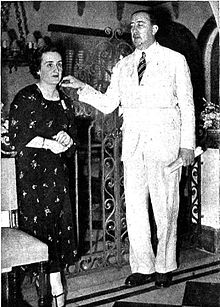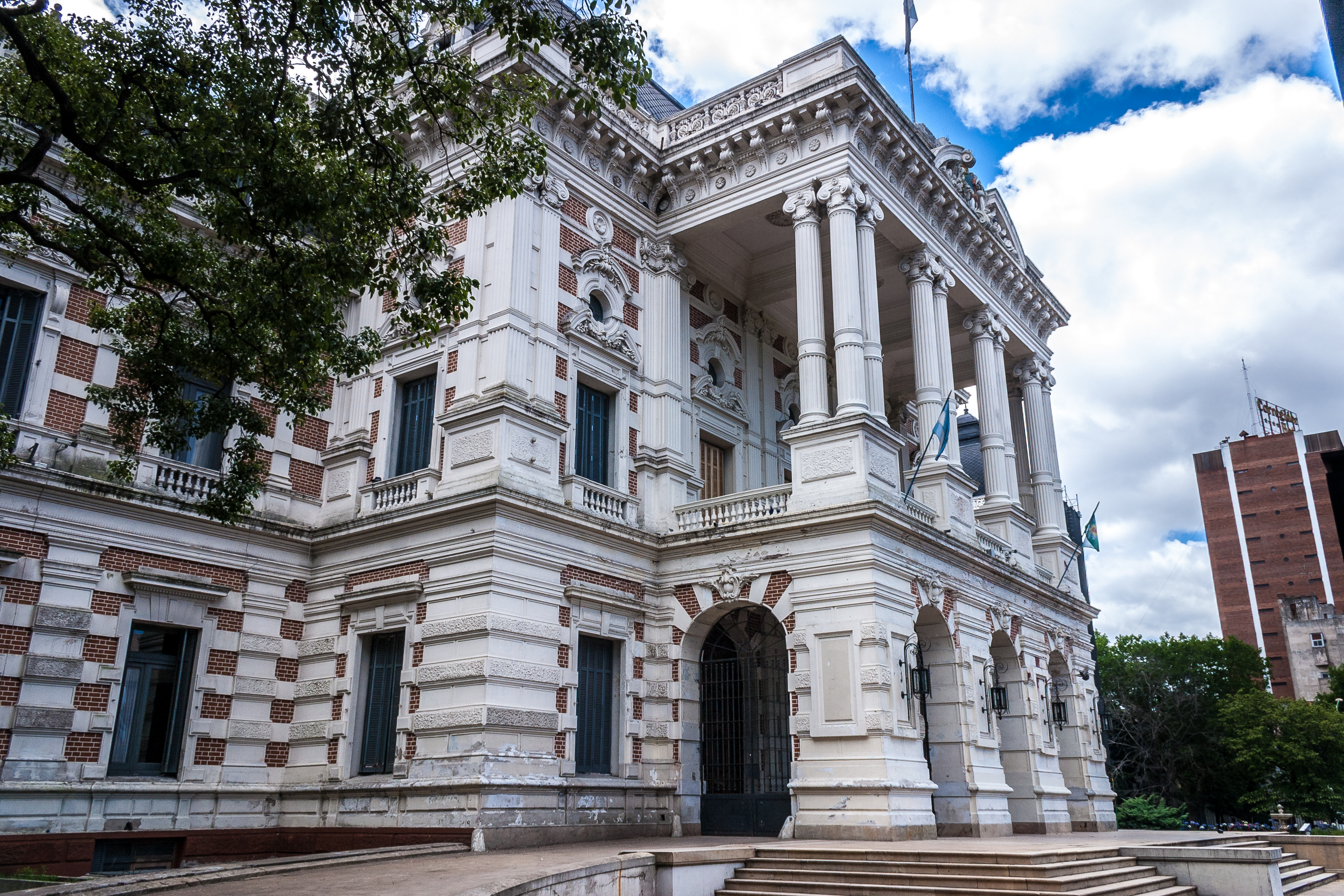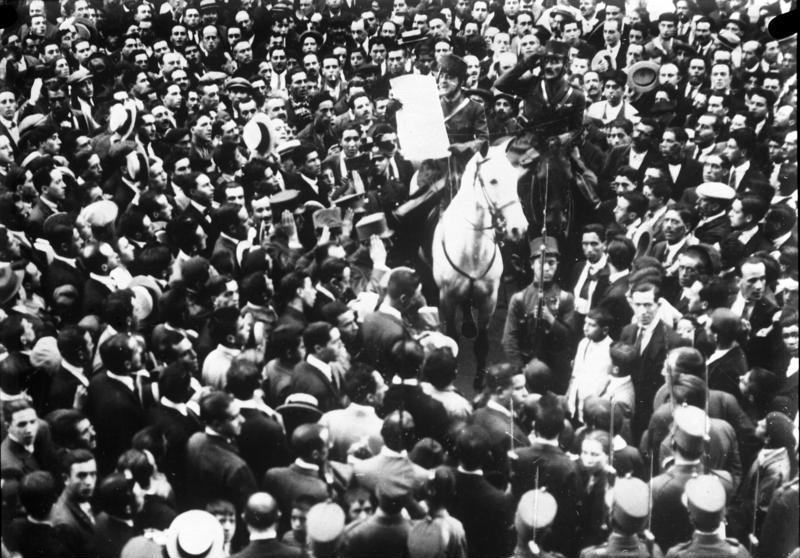|
Manuel Fresco
Manuel Antonio Justo Pastor Pascual Fresco (June 3, 1888 in Navarro, Buenos Aires – November 17, 1971 in Buenos Aires) was an Argentine doctor and Politician, national deputy and governor of Buenos Aires Province between 1936 and 1940 for the conservative National Democratic Party. Early life and education Fresco was the son of Manuel Antonio Fresco from Salta and María Josefa Escarpati. During his youth he devoted himself to fencing, achieving some sporting success. He received his medical degree in 1914 at the University of Buenos Aires; one of his classmates was the socialist leader Alicia Moreau de Justo. Career Medical and early political career Installed in Avellaneda, province of Buenos Aires, he was an active collaborator of the local conservative caudillo, Alberto Barceló. Later he was appointed doctor of the Western Railway of Buenos Aires, settling for life in the town of Haedo In the year 1919 he became a deputy of the Province of Buenos Aires, occupying a va ... [...More Info...] [...Related Items...] OR: [Wikipedia] [Google] [Baidu] |
Governor Of Buenos Aires Province
The Governor of Buenos Aires Province ( es, Gobernador de la Provincia de Buenos Aires) is a citizen of the Buenos Aires Province of Argentina, holding the office of governor for the corresponding period. The governor is elected alongside a vice-governor. Currently the governor of Buenos Aires Province is Axel Kicillof since December 11, 2019. Requirements To be able to be elected governor, the person must be an Argentine citizen and must have been born in Argentina, or be the child of an Argentine citizen if born in a foreign country.Constitución de la Provincia de Buenos Aires - Art- 121 The citizen must also be at least 30 years old, and have at least 5 uninterrupted years of residence in the province if not natural from it. The term lasts 4 years, with the chan ... [...More Info...] [...Related Items...] OR: [Wikipedia] [Google] [Baidu] |
Enrique Finochietto
Enrique Finochietto (March 13, 1881 – February 17, 1948) was a distinguished Argentine academic, physician and inventor. Life and work Enrique Finochietto was born in 1881 in Buenos Aires to Ana and Tomás Finochietto. His father died during his early childhood, and he was raised mostly by his mother. He excelled in industrial design while in secondary school, and enrolled at the University of Buenos Aires in 1897.Agencia el Viglia: Enrique Finochietto Finochietto interned at the university's Clinical Hospital, becoming an assistant to a noted surgeon, Dr. . His thesis, ''El Pie-Bot Varus-Equino-Congénito'', earned him a |
Clarín (Argentine Newspaper)
''Clarín'' (, meaning "Bugle"), is the largest newspaper in Argentina and the second most circulated in the Spanish-speaking world. It was founded by Roberto Noble in 1945, published by the Clarín Group. For many years, its director was Ernestina Herrera de Noble, the founder's wife. ''Clarín'' is part of ''Periódicos Asociados Latinoamericanos'' ( Latin American Newspaper Association), an organization of fourteen leading newspapers in South America. History ''Clarín'' was created by Roberto Noble, former minister of the Buenos Aires Province, on 28 August 1945. It was one of the first Argentine newspapers published in tabloid format. It became the highest sold Argentine newspaper in 1965, and the highest sold Spanish-speaking newspaper in 1985. It was also the first Argentine newspaper to sell a magazine with the Sunday edition, since 1967. In 1969, the news were split into several supplements by topic. In 1976, high color printing was benefited by the creation of A ... [...More Info...] [...Related Items...] OR: [Wikipedia] [Google] [Baidu] |
Roberto Noble
Roberto Noble (9 September 1902 – 12 January 1969) was an Argentine politician, journalist and publisher, perhaps best known for having founded '' Clarín'', long Argentina's leading news daily and the most or second-most circulated in the Spanish-speaking world. Life and times Early career Born to privilege in the city of La Plata, Roberto Noble developed a socialist ideology as an adolescent, having already earned some renown by 1918 agitating for the movement to reform Argentina's university system, whose curriculum had hitherto been largely dictated by conservative Catholics. Obtaining a Law Degree at the prestigious National University of La Plata, he joined the Socialist Party of Argentina, and later aligned himself with the dissident Independent Socialists. This party split from the Socialist Party to seek an alliance with conservatives sharing their distaste for the populist Hipólito Yrigoyen for the 1928 elections (which Yrigoyen won). Noble was a vocal advocate fo ... [...More Info...] [...Related Items...] OR: [Wikipedia] [Google] [Baidu] |
Mar Del Plata
Mar del Plata is a city on the coast of the Argentine Sea, Atlantic Ocean, in Buenos Aires Province, Argentina. It is the seat of General Pueyrredón Partido, General Pueyrredón district. Mar del Plata is the second largest city in Buenos Aires Province. The name "Mar del Plata" is a shortening of "Mar del Rio de la Plata," and has the meaning of "sea of the Rio de la Plata basin" or "adjoining sea to the (River) Plate region". Mar del Plata is one of the major fishing ports and the biggest seaside Balneario, beach resort in Argentina. With a population of 614,350 as per the , it is the List of cities in Argentina by population, 5th largest city in Argentina. Economy As part of the Argentine recreational coast, Tourism in Argentina, tourism is Mar del Plata's main economic activity with seven million tourists visiting the city in 2006. Mar del Plata has a sophisticated tourist infrastructure with numerous hotels, restaurants, casinos, theatres and other tourist attractions. ... [...More Info...] [...Related Items...] OR: [Wikipedia] [Google] [Baidu] |
Bariloche
San Carlos de Bariloche, usually known as Bariloche (), is a city in the province of Río Negro, Argentina, situated in the foothills of the Andes on the southern shores of Nahuel Huapi Lake. It is located within the Nahuel Huapi National Park. After development of extensive public works and Alpine-styled architecture, the city emerged in the 1930s and 1940s as a major tourism centre with skiing, trekking and mountaineering facilities. In addition, it has numerous restaurants, cafés, and chocolate shops. The city has a permanent population of 108,205 according to the 2010 census. According to the latest statistics from 2015, the population is around 122,700, and a projection for 2020 estimates 135,704. History The name ''Bariloche'' comes from the Mapudungun word ''Vuriloche'' meaning "people from behind the mountain" ( = behind, = people). The Poya people used the Vuriloche pass to cross the Andes, keeping it secret from the Spanish priests for a long time. There is evid ... [...More Info...] [...Related Items...] OR: [Wikipedia] [Google] [Baidu] |
Alejandro Bustillo
Alejandro Bustillo (18 March 1889 – 3 November 1982) was an Argentine painter and architect who left his mark in various tourist destinations in Argentina, especially in the Andean region of the Patagonia. Biography Born in Buenos Aires, son of María Luisa Madero and Dr. José María Bustillo, he completed his secondary school studies at Otto Krause Technical School. He later entered the School of Architecture at the University of Buenos Aires, where he also excelled as a painter, earning a first prize at the 1912 National Salon of Painters for a self-portrait. He graduated with a degree in Architecture in 1914. He obtained his first professional experience working on the design of estancias, the first of which was for Santiago Rocca in 1916. He married Blanca Ayerza in 1917, and the couple had eight children. Bustillo designed a country house for his own family, ''Estancia La Primavera'', in 1918. Two years later he returned to Buenos Aires. After a visit to Paris, Bustil ... [...More Info...] [...Related Items...] OR: [Wikipedia] [Google] [Baidu] |
Marcos Paz, Buenos Aires
Marcos Paz is the capital of Marcos Paz Partido, in the Greater Buenos Aires urban agglomeration in the Argentine province of Buenos Aires, located 48 kilometres west of Buenos Aires. Although the city of Marcos Paz was officially founded in 1878, the city was first established in 1870, near the Estación Coronel Doctor Marcos Paz railway station. With a population of 39.529 (INDEC 2001), it is the county's largest (and only) city. Famous residents * Juan Carlos Onganía Carballo (1914–1995), military dictator and President of Argentina from 29 June 1966 to 8 June 1970. * Jorge Rafael Videla (1925–2013), military dictator and President of Argentina from 29 March 1976 to 29 March 1981. * Rodolfo Arruabarrena Rodolfo Martín Arruabarrena (born 20 July 1975) is an Argentine professional football manager and former footballer, who is the current head coach of the United Arab Emirates national football team. As a footballer, he played as a left back ..., football player, c ... [...More Info...] [...Related Items...] OR: [Wikipedia] [Google] [Baidu] |
National Congress Of Argentina
The Congress of the Argentine Nation ( es, Congreso de la Nación Argentina) is the legislative branch of the government of Argentina. Its composition is bicameral, constituted by a 72-seat Senate and a 257-seat Chamber of Deputies. The Senate, whose members are elected to six-year terms renewable by thirds each two years, consists of three representatives from each province and the federal capital. The Chamber of Deputies, whose members are elected to four-year terms, is apportioned according to population, and renews their members by a half each two years. The Congressional Palace is located in Buenos Aires, at the western end of Avenida de Mayo (at the other end of which is located the Casa Rosada). The ''Kilometre Zero'' for all Argentine National Highways is marked on a milestone at the Congressional Plaza, next to the building. Attributes The Argentine National Congress is bicameral, composed of the Senate and the Chamber of Deputies. The ordinary sessions span is fro ... [...More Info...] [...Related Items...] OR: [Wikipedia] [Google] [Baidu] |
Agustín Pedro Justo
Agustín Pedro Justo Rolón (26 February 1876 – 11 January 1943) was an Argentine military officer, diplomat and politician, who served as the president of Argentina from 1932 to 1938 during the Infamous Decade. Justo took part in the coup of 1930, becoming president two years later thanks to widespread electoral fraud. His presidency was part of the period known as the Infamous Decade, which lasted from 1930 until 1943. He established the country's central bank and introduced a nationwide income tax. Appointed War Minister by President Marcelo Torcuato de Alvear, his experience under a civilian administration and pragmatic outlook earned him the conservative Concordance's nomination for the 1931 campaign. He was elected president on 8 November 1931, supported by the political sectors that would form shortly after la Concordancia, an alliance created between the National Democratic Party (''Partido Demócrata Nacional''), the Radical Civic Union (''Unión Cívica Radical'' ... [...More Info...] [...Related Items...] OR: [Wikipedia] [Google] [Baidu] |
Argentine Chamber Of Deputies
The Chamber of Deputies ( es, Cámara de Diputados de la Nación), officially the Honorable Chamber of Deputies of the Argentine Nation, is the lower house of the Argentine National Congress ( es, Congreso de la Nación). It is made up of 257 national deputies who are elected in multi-member constituencies corresponding with the territories of the 23 provinces of Argentina (plus the Federal Capital) by party list proportional representation. Elections to the Chamber are held every two years, so that half of its members are up in each election, making it a rare example of staggered elections used in a lower house. The Constitution of Argentina lays out certain attributions that are unique to the Chamber of Deputies. The Chamber holds exclusive rights to levy taxes; to draft troops; and to accuse the President, cabinet ministers, and members of the Supreme Court before the Senate. Additionally, the Chamber of Deputies receives for consideration bills presented by popular i ... [...More Info...] [...Related Items...] OR: [Wikipedia] [Google] [Baidu] |
Miguel Primo De Rivera
Miguel Primo de Rivera y Orbaneja, 2nd Marquess of Estella (8 January 1870 – 16 March 1930), was a dictator, aristocrat, and military officer who served as Prime Minister of Spain from 1923 to 1930 during Spain's Restoration era. He deeply believed that it was the politicians who had ruined Spain and that by governing without them, he could restore the nation. His slogan was "Country, Religion, Monarchy." On the death of his uncle in 1921 he became Marquess of Estella. With the support of King Alfonso XIII and the army, Primo de Rivera led a Mussolini-inspired military coup on 13 September 1923.Television documentary from CC&C Ideacom Production,"Apocalypse Never-Ending War 1918-1926", part 2, aired on DR K on 22 October 2018 He was appointed Prime Minister by the King. He promised to eliminate corruption and to regenerate Spain. In order to do this he suspended the constitution, established martial law, imposed a strict system of censorship, and ended the '' turno'' ( ... [...More Info...] [...Related Items...] OR: [Wikipedia] [Google] [Baidu] |


.jpg)


.jpg)
